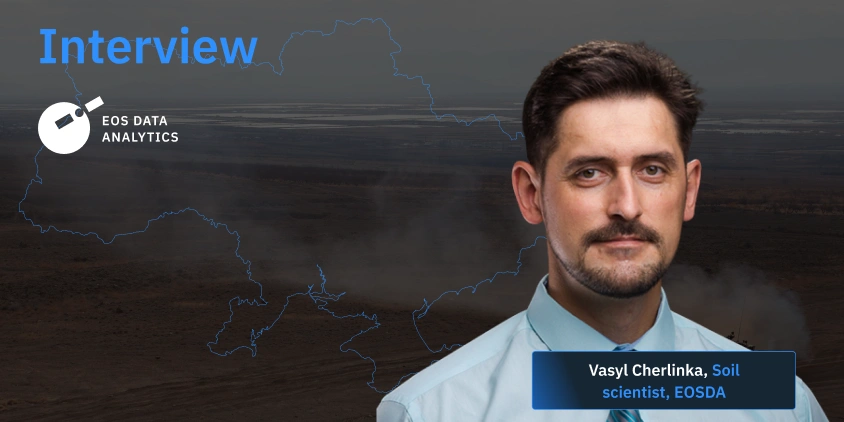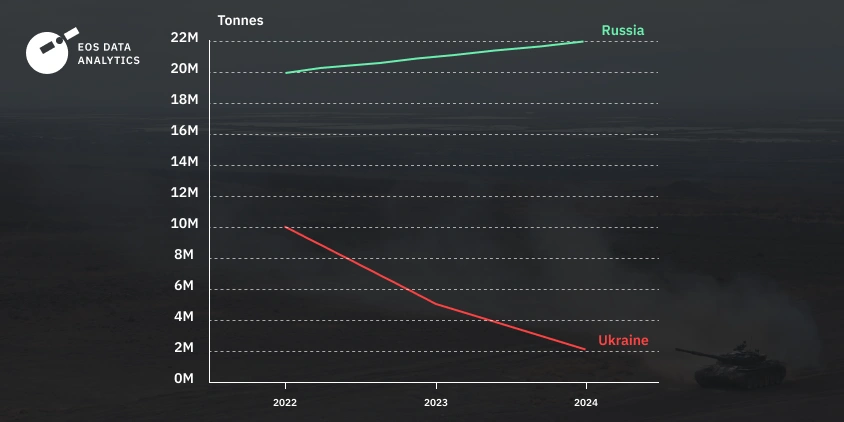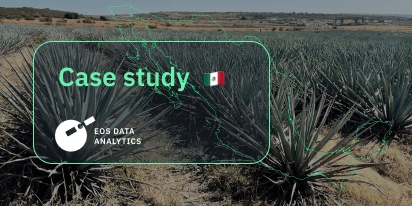
The Impact Of War In Ukraine On Global Food Security
The ongoing war in Ukraine has brought unprecedented challenges to the country’s agricultural sector, impacting global food security and highlighting the critical importance of soil health. In response to these challenges, EOS Data Analytics has launched the ‘Harvesting Hope’ initiative, which features an interactive map showcasing key historical and forecasted crop yields in Ukraine from 2021-2024. This initiative aims to support Ukrainian farmers by providing free access to EOSDA Crop Monitoring, helping them navigate adversities and ensure a sustainable future for Ukraine’s agricultural sector.
To delve deeper into the impact of the war on global food security and the role of soil science in addressing these challenges, we spoke with Dr. Vasyl Cherlinka, a seasoned soil scientist with EOS Data Analytics. With over 30 years of experience, Dr. Cherlinka shares his insights on how the war has affected soil conditions and crop yields, the importance of sustainable soil management, and the technological innovations that can help farmers adapt to these harsh conditions.
Read on to learn more about the long-term solutions for ensuring global food security and the crucial steps needed to restore and maintain soil health in war-affected regions.
Based On Your Research, How Has The War Specifically Affected Soil Conditions And Crop Yields In Ukraine?
The war has had a profound impact on our soil and crops. You see, it introduced a range of destructive factors that affect both the soil cover and the vegetation it supports.
Movement of heavy machinery and contamination with fuel and lubricants lead to soil and plant cover degradation. Various munitions, such as mines and shells, create craters and scatter debris, including heavy metals, across fields. Fortifications disrupt the hydrological regime of soils, while fires destroy natural and agricultural ecosystems. Explosive residues and their byproducts pollute soils and plants.
Although Russia hasn’t used certain destructive agents like herbicides or chemical weapons in this war, their potential use remains a critical concern. If such agents were deployed, the consequences for soil and all living organisms could be devastating, with effects lasting for generations.
Can You Provide Some Examples Of Soil Degradation And Damage In Regions Heavily Affected By The War?
Absolutely. The war has caused significant physical and chemical degradation of soils in various regions. Let me break it down for you with some examples.
Physical degradation:
- The construction of fortifications alters the physical characteristics of the landscape, affecting the natural flow of surface and groundwater.
- Bombing and artillery strikes create craters and displace large volumes of soil, significantly transforming the landscape by mixing soil layers.
- Anti-tank and anti-personnel mines disrupt soil layers and leave behind plastic and metal fragments along with explosive residues.
- Heavy machinery compacts the soil, making it more susceptible to erosion and runoff, and in arid regions, it can even lead to desertification.
- Fires in agricultural and forest areas increase the susceptibility to erosion on steep, burnt surfaces, degrade moisture infiltration, and destroy soil flora and fauna.
Chemical degradation:
- Metal residues, like bullets, release lead and other toxic elements (Sb, Cr, As, Hg, Ni, Zn, Cd) into the soil over time.
- Explosives and fuel contaminants, which are widespread pollutants, are regulated by both abiotic and biotic processes. Their physical and chemical properties, along with environmental and biological factors, play a crucial role in their transportation and transformation.
- Chemical warfare agents are designed to incapacitate or kill based on their toxic properties. While many breakdown products of nerve agents are less toxic, some can form more persistent and harmful compounds. Let’s hope that they will not be used, since, for example, 110 years after the First World War in France, a number of territories are still contaminated by these substances.
Given the current length of the frontline and the extent of the liberated territories in the north and northeast, around 3,200 kilometers in total, with intense fighting along 1,200 kilometers, the soils have suffered immense damage . Over 90,000 square kilometers have become either entirely or partially unusable due to the factors mentioned .
Unfortunately, assessing crop yield losses due to soil degradation is challenging at the moment. Precise measurements of contamination and long-term soil productivity loss will only be possible after the war ends and demining is completed. However, we can already estimate significant yield losses in certain regions due to disrupted agricultural activities, financial constraints on purchasing fuel, fertilizers, seeds, and pesticides, increased logistics costs, and even the loss of harvested crops due to transport issues.
Restoring the soils to their pre-war state will be a multifaceted process involving careful planning, assessment, and application of appropriate methods based on the specific needs of the soil and land use goals. This means focusing on sustainable agricultural production, advanced soil management practices, ecosystem protection, climate change mitigation, and biodiversity conservation. Our high-resolution predictive soil mapping offers substantial opportunities for accurately assessing damage and planning for soil recovery.
The Disruption Of Ukrainian Grain Exports Has Had Significant Global Consequences. Can You Elaborate On The Most Critical Impacts On Global Food Security?
The war has severely disrupted global food supply chains, particularly affecting wheat, corn, and sunflower oil exports. Before the invasion, Ukraine was a leading exporter, holding top positions globally for these commodities. The war has drastically reduced agricultural production and complicated exports due to damaged infrastructure and blockades. Moreover, large quantities of Ukrainian grain have been stolen and rebranded by Russia .
This disruption has led to a sharp increase in global food prices, exacerbating food security issues, especially in developing countries . For instance, countries like Egypt, Turkey, and Bangladesh, which heavily rely on Ukrainian grain, have faced severe challenges. In 2021, China and Egypt were major markets for Ukrainian grain, but the 2022 maritime blockade shifted this dynamic. Russia filled the gap left by Ukraine, occupying about 90% of the grain export volumes to China that Ukraine used to supply.
The blockade of Black Sea ports and logistical issues have forced Ukraine to use more expensive and less efficient land routes, increasing costs and reducing export volumes. Although some stability has returned, the situation remains far from the pre-war status quo, with ongoing risks to global food availability and accessibility.
Given Your Expertise, How Do You Assess The Potential Long-Term Consequences For Global Food Prices And Availability?
The long-term consequences look challenging. The war continues, and Ukraine is fighting hard, but in my opinion, the global South’s surprising stance of tacit support or neutrality towards Russia complicates matters.
According to WTO data, the overall wheat export situation until January 2024 paints a grim picture .

A major emerging issue is the shortage of labor in agriculture. The lack of mobilization exemptions for farmers with smaller operations (less than 1,000 hectares) could significantly reduce production levels, exacerbating the situation. Infrastructure destruction, power shortages, and ongoing warfare further compound the problem.
Analyzing food price changes from December 2022 to December 2023 shows inflation decreasing in developed economies like the UK and the US, but rising in weaker economies . Additionally, recent attacks by Yemeni Houthis in the Red Sea have disrupted traffic, increasing prices in regions heavily dependent on Ukrainian exports.
Ending the war in Ukraine and restoring export flows could significantly alleviate global food availability issues, making food more affordable for countries currently suffering the most from the war’s impact.
Your Research Highlights The Importance Of Soil Health For Agricultural Resilience. What Specific Soil Management Practices Do You Recommend To Mitigate The Adverse Effects Of The War?
Effective soil management practices are crucial for minimizing soil degradation caused by the war and restoring soil health. Key methods include increasing organic matter input, minimizing tillage, optimizing fertilization, and implementing crop rotations and sustainable agrochemical use. These practices not only help restore but can also enhance soil properties.
Aligning with the EU Soil Strategy, which aims for at least 75% of soils in each EU member state to be healthy by 2030, Ukraine aspires to reach these high standards . Despite the current challenges, adopting comprehensive soil management practices is essential.
Soil restoration involves a combination of remediation, reclamation, regeneration, and rehabilitation. Tailoring these strategies to specific soil types, as highlighted in our research, will support soil health and resilience, boosting agricultural productivity both in war-affected areas and across the country.
How Can Soil Science Contribute To Developing Effective Adaptation Strategies For Farmers In War Zones?
I believe this issue is quite complex and there is no single answer to it. For example, Bilali & Hassen (2024) note that Ukrainian farmers have adapted by exploring alternative export routes and increasing the use of organic and inorganic fertilizers to maintain soil productivity . However, internal feedstock processing strategies are also critical for sustaining agricultural productivity during the war.
Also, farmers near the frontlines face unique challenges. If a worker is under constant threat of attack or landmines, no strategy can fully ensure their safety or even their life. In such conditions, the general problems of logistics, fuel, seeds, fertilizers, and pesticides are magnified, making it nearly impossible to establish highly effective agriculture. The fact that farming persists in these areas at all is a testament to the resilience and determination of these farmers.
Therefore, while soil science, agronomy, and agriculture can offer effective recommendations, implementing them in war zones remains a significant challenge. The primary concern in these areas is the safety and survival of the farmers, making practical application of these strategies very difficult.
How Has The Integration Of Satellite Data And Other Technological Innovations Supported Soil Health And Agricultural Practices In Ukraine?
High-resolution satellite imagery and advanced analytics from EOSDA allow farmers to monitor crop health, assess soil conditions, and accurately predict weather patterns. These capabilities reduce the need for field visits, which is crucial in war zones, thereby enhancing production processes and minimizing risks for individuals.
This approach is a key element of modern precision agriculture but is also successfully used in traditional farming. By leveraging remotely collected data, farmers can better manage resources, reduce costs, and increase overall productivity, even under challenging circumstances.
What Do You See As The Most Promising Long-Term Solutions For Ensuring Global Food Security, Particularly From A Soil Science Perspective?
Sustainable soil management in every country and close international cooperation are vital for long-term food security. For Ukraine, enhancing agricultural resilience is achievable through technological advancements and international support, which can help restore the agricultural sector and stabilize global food supplies.
Increasing agricultural resilience also depends on Ukraine’s ability to succeed both on the battlefield and diplomatically. Victory in the war is a key indicator that efforts to restore soil health and pre-war production levels will be successful, ultimately ensuring global food security in the long term.
What Message Would You Like To Convey To The Global Community About The Importance Of Supporting Soil Health And Sustainable Agriculture?
A: According to the UN, around 12 million hectares of soil are lost annually due to degradation . This issue is understood by international organizations, countries, and individual farmers. The global community has recognized the critical role of soil health in agricultural sustainability and production stability. For instance, the EU’s European Green Deal places significant emphasis on soil health in its soil strategy.
Continued support for research and development in soil science, agronomy, and agriculture, combined with international cooperation, is essential to address global food security challenges and support regions affected by war.
How Can Individuals And Organizations Contribute To Efforts Aimed At Supporting Soil Health And Ensuring Agricultural Resilience In War-Affected Regions?
A: Soil health involves a complex interplay of factors that can be assessed through various criteria. By following a clear framework for evaluating soil degradation, individuals and organizations can identify ways to mitigate these processes.
They can contribute by supporting initiatives that promote soil health, adopting sustainable agricultural practices, and leveraging available technological innovations. Even partial restoration of soil ecosystem functions in war zones can have significant benefits, which will be fully realized in post-war times.
Moreover, participating in global efforts to provide financial, technical, and humanitarian aid to war-affected regions can help maintain and restore agricultural productivity. Together, these actions can make a substantial difference in supporting soil health and agricultural resilience.
About the author:
Maksym Sushchuk is at the forefront of realizing EOSDA's vision to make space tech a global driver of sustainability on Earth. He has over 15 years of experience in journalism and content creation for prominent Ukrainian startups, charitable funds and ESG businesses. As Head and Co-founder of PR Army Maxim brings attention to the human and social tolls of the aggression against Ukraine.
Recent articles

Digital Tools Improve Soil Health And Yields In Mexico
EOSDA and ITTA supported a Guanajuato farm with contour-line planning, monitoring tools, and practical guidance to reduce soil erosion and improve yields in the long run.

Analyze 2025 & Plan Your Best Year Yet: LandViewer Christmas Offer
It’s the most wonderful time of the year! The Christmas holidays are here, and so is your chance to analyze 2025 and plan a prosperous 2026 with more affordable Pro plans in LandViewer.

EOSDA Models Climate Change Impact On Sugarcane Yields
EOSDA modeled future temperature, rainfall, and other climate impacts on Veracruz sugarcane. The results help growers plan long-term adaptation strategies, including timing, varieties, and irrigation.